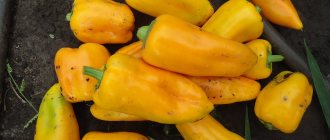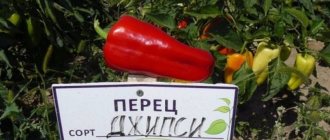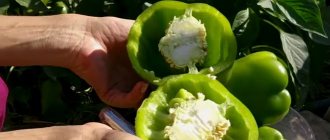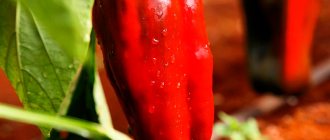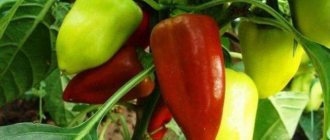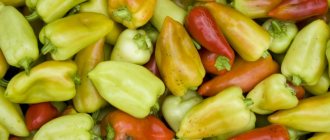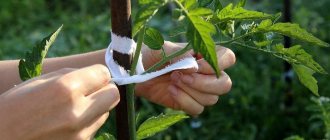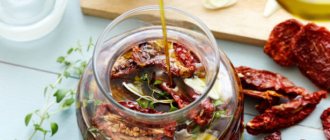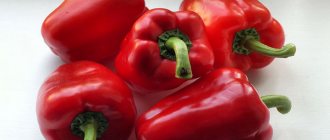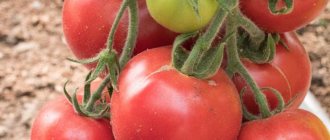Description and characteristics of the variety
Ox's ear sweet pepper is classified as a mid-season species based on the harvest date. Peppers ripen in 110-125 days to a state of full technical ripeness.
In the bell pepper Ox's Ear, the height of the bushes varies in the range of 65-75 cm. Their stems are durable and strong, and do not break under the weight of the fruit. The plants are semi-standard, the bushes are spreading and moderately leafy. When planting, it is recommended to maintain a distance of at least 50 cm between vegetables.
Hybrid or variety? Pepper is a varietal species. To obtain seedlings, you can use your own harvested seeds.
What are the signs of fruits:
- average weight 200-230 g;
- pericarp 6-7 mm;
- length 12-15 cm;
- diameter 7-9 cm;
- aligned conical shape;
- the outer wall is glossy, with iridescence;
- the color is deep red when ripe (initially green);
- the pulp is juicy and fleshy.
Pepper has a balanced taste - sweetness and sourness are perfectly combined. Such fruits are ideal for preparations in the form of lecho, adjika, and ajvar. They add a refined taste and peppery aroma to salads and hot dishes. When there is an abundance of harvest, many housewives make pepper paste. They are also pickled and preserved whole (the compact size allows this to be done).
Comparison with similar varieties
Ox's ear has many similarities to different varieties of peppers. To do this, it’s worth looking at some of the characteristics of the closest ones:
- Frost - has the main advantage over Ox Ear - resistance to cold. It is very popular among gardeners because it can be planted not only in a greenhouse, but also on the site. The ripening period is 110 days, just like Ox Ear tolerates transportation and storage well.
- Flight - has a longer maturation period (about 4 months). Resistant to rot and temperature changes. High yield. The fruits weigh 90-110 grams. The taste is sweet, rich. Well suited for both canning and fresh consumption.
- Pharaoh is an early ripening variety. The ripening period is 60-65 days. Fruit weight 120-140 g. Tolerates transportation and long-term storage.
As you can understand, Ox Ear has many advantages, but it can be planted mainly in greenhouses. In addition, the features require constant attention and care from the gardener.
Landing
The seeds are soaked in warm water, then in potassium permanganate, and finally treated with a stimulant (Epin, Zircon, humate). Exposure time – 20-24 hours. The sowing time for seedlings is from mid-February to March.
They use store-bought mixtures for peppers and tomatoes, which contain peat, turf and humus. It is possible to independently prepare the soil mixture, which should then be disinfected. Apply 1% potassium permanganate, boiling water or calcination in the oven.
Seedlings can be grown with or without picking. From containers, pots of 0.3-0.4 liters are suitable. At 60 days, transplantation is carried out to a permanent place.
The nuances of growing Ox's Ear pepper
Cultivation should begin with careful selection of seed material. Typically, those seeds that are purchased in specialized stores from well-known companies have already undergone all pre-sowing preparation:
- only viable seeds were selected;
- the material is disinfected and treated with growth stimulants.
Before planting, it is better to soak the pepper seeds for a couple of hours. The containers are filled with ready-made soil mixture for vegetable plants. It is better to plant the seeds in small cups, a couple of pieces in each, because peppers should not be subjected to unnecessary transplants (including picking) - the plants get very sick after such a procedure. The seed should be buried 0.5 - 0.8 cm into the soil. After planting, the soil is moistened and covered with polyethylene on top to create a greenhouse effect.
After the emergence of mass shoots, the film is removed from the containers, weak plants are removed, leaving only strong seedlings. In the first ten days of May, peppers are ready for planting in protected soil (at the stage of 5–7 permanent leaves). Seedlings are planted in open ground in the middle - end of May, when the danger of spring frosts has passed.
When preparing beds for seedlings, you should remember the rules of crop rotation. The best predecessors for sweet peppers:
- peas, beans, soybeans;
- various green manures;
- cucumbers;
- dill.
You should absolutely not plant peppers after tomatoes - the crops are susceptible to the same diseases. The landing site should be sunny. In greenhouse conditions, the room should be regularly ventilated.
Particular attention should be paid to watering: irrigation is carried out once every 3 days, for each pepper bush - at least 1.5 liters of water. Before the ovaries appear, it is better to use sprinkling; during fruit set and ripening, moisture is applied to the root
During the growth and ripening of the crop, alternate fertilizing with superphosphate and organic fertilizers (slurry or chicken droppings).
Reviews from vegetable growers who regularly grow Oxen's Ear indicate that this variety is resistant to the tobacco mosaic virus.
Growing and care
Cultivation is carried out in the traditional way.
Formation
Forming allows you to achieve higher yields and quality of peppers. When the main stem grows to 23-26 cm, branching and the formation of a flower bud begins - it should be pinched. At the same time, remove all unnecessary shoots and leaves.
Leave 2 main trunks from the fork zone of the crown bud.
Watering
Immediately after planting the bushes, watering is not carried out for 7-8 days. Then, before flowering, moisten moderately 1-2 times a week. When filling and ripening peppers, the frequency of watering is up to 2-3 times every 7 days (taking into account humidity and precipitation). When it gets colder, they irrigate less frequently.
Use settled water heated in the sun. The time of the procedure is morning or evening.
Water is poured under the root or into the grooves. A drip system is installed to ensure proper irrigation. The norm for 1 plant is from 1 to 3.5 liters of liquid.
Feeding
Peppers should be fed throughout the season. This contributes to the strength of the bushes and maximum productivity. Ash (a source of potassium) is used in dry form and in infusions. Dilute 300-400 g per 10 liters.
For fertilizing 2 weeks after transplantation, nitrogen mixtures, urea, urea, and complexes (Novosil, Malyshok, Agricola) are suitable. You can use chicken manure or mullein (1 to 10 dilution). Fertilizer is applied after watering to avoid burning the root system.
At the flowering stage, use the following composition per 10 liters:
- 1 tsp urea;
- 1.5 tbsp. superphosphate;
- 1 tsp potassium sulfate.
The solution is applied at the rate of 1 liter per plant. It is also good to use nitrogen-phosphorus compounds and nitrophoska (diluted 40 g per 10 l).
The third feeding begins when the peppers are formed and poured. Good results are obtained from Agikola-Vegeta, Effecton, Dobrivo, Ideal.
The norm per 1 m2 is 5 liters of prepared solution.
Suitable mineral mixtures:
- superphosphate (40 g per 1 bucket);
- ash (0.5 kg per 10 l);
- potassium sulfate (1.5 tbsp per 1 bucket).
Sun protection
At the height of the heat and maximum solar activity, it is recommended to use lutrasil or a shading mesh for shading. Options with rates of 40-50% are suitable for moderate latitudes. In the south, more significant protection will be required with a density of 55-65%. By color, you can use gray or blue-green mesh.
Treatments
To prevent MMR, plants are irrigated with Oxychom or Kuproxat. To protect plantings from the Colorado potato beetle, use Commander, Prestige, Regent. Avoid slugs using quicklime, mustard, and hot pepper powder. Measures against ticks include spraying with tobacco infusion (300 g per 10 l), Malathion.
Recommendations for cultivation
Professionals advise growing this variety through seedlings. And in order to prepare it, they begin to engage in this procedure in advance in March or early April.
This variety grows well in ordinary soil, but for comfortable further growth, when growing seedlings at home, it is advisable to add a little soil to the container from the place where the bushes will be planted in the future. Then young plants will not have a hard time getting used to new conditions, they will sprout together.
In order for the seeds to germinate well without any problems, a number of important actions are necessary:
Only living seeds are needed for growth. To test them, place them in a container of water. Those that immediately rose to the surface have already dried out and need to be disposed of. The selected seeds must be soaked in settled water at room temperature for several days. For further improved growth, it is advisable to treat with a very weak solution of potassium permanganate, then rinse the seeds with slightly warmed water - to room temperature. This method helps the Ox Ear acquire the necessary immunity and will enable it to grow better. Prepared seeds are placed in containers, most often convenient peat pots with prepared soil, and covered with film to create a comfortable microclimate. Usually they ripen together, but only if the room temperature is the same, approximately +18 - +20 degrees. It is advisable to plant 2 - 3 seeds in each container, since their germination rate is usually not so high, and is only slightly above 50 percent. Taking this into account, you need to plant seeds 2 or even 3 times more than the planned amount.
And please note: it has been noticed that sweet pepper varieties are very sensitive to picking.
As soon as the seedlings have sprouted, you need to remove the weak sprouts, leaving the strongest ones.
Advantages and disadvantages
This variety has many advantages:
- ideal for growing both at home and for industrial purposes;
- can be grown both in greenhouses and in open ground;
- high-yielding, up to 3 kg per bush;
- excellent taste, even in fruits of technical maturity (colored green);
- resistant to many diseases;
- preserves well during transportation.
Among the disadvantages are:
- poor seed germination;
- does not tolerate picking;
- does not like extreme heat and very low temperatures.
Features of growing the variety
Many, especially novice vegetable growers, are afraid to grow peppers on their own, citing the fact that the culture is very capricious. At the same time, by strictly following the technological plan, you can easily grow an excellent harvest.
Growing seedlings
Before sowing seeds, you need to take care of the soil mixture. The best option is to purchase universal soil for seedlings in a specialized store. This soil meets all the requirements, it:
- nutritious;
- enriched with mineral components necessary specifically for seedlings;
- balanced in acidity;
- breathable;
- water permeable.
Each vegetable grower chooses the time for sowing seeds in accordance with his region. In this case, there is a single rule for everyone: “When planting, seedlings must be 60-65 days old.”
In order for the seeds to germinate quickly and amicably, they must be warmed up and given the opportunity to hatch. To do this, the seeds should be wrapped in a damp cloth and placed in a plastic bag, and then in a warm place. After 3-4 days, you need to start sowing, but only with those seeds that have shown signs of life.
Sowing can be carried out in a common container, spreading the seeds 2-3 cm apart, and in the state of 2 true leaves, carefully plant them in individual pots. You can immediately sow containers one seed at a time.
When the seedlings rise 6-7cm, it is advisable to pinch the top. It will stop growing for a while, and then show two side shoots. This technique will force the plant to form a bush and the yield will increase.
